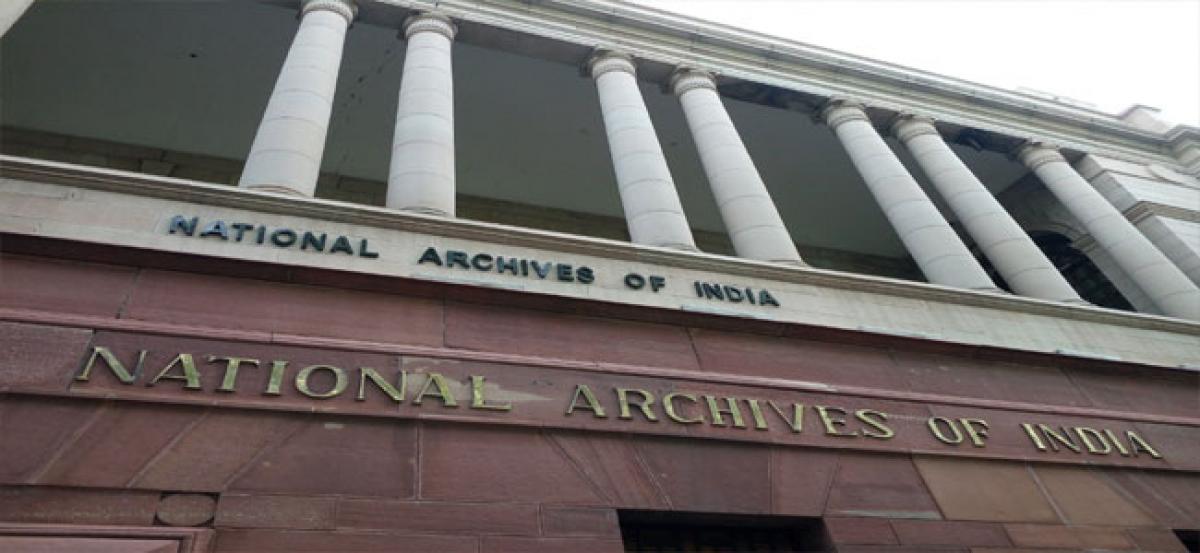Live
- Yoga Pranayama Exercises for Heart Health
- DSP dies in gun misfire at CRPF camp in Bhadrachalam
- World Malaria Day 2024: Date, History, Significance, and Importance
- International Noise Awareness Day 2024: Date, History, Significance, and Essential Information
- Sushant Singh Rajput's pic with Dhoni and baby daughter goes viral, fans get emotional
- Harish Rao challenges Congress govt. to implement loan waiver by August 15
- German far-right's top EU candidate to carry on despite aide's arrest
- Metal, PSU stocks lead market gains
- Congress ready to set 'dangerous precedent' by implementing Inheritance Tax: PM Modi
- Countdown starts for polling for 14 LS seats in K'taka, public campaigning to end today
Just In

The National Archives of India, repository of some of the oldest and rarest records pertaining to the country, has introduced a thematic book reading series, seeking to bring scholars, historians and especially the youth, closer to the archival treasure housed in its premises. Director General of the NAI, Pritam Singh, recently launched the series titled \'Archives Reads\' here.
New Delhi: The National Archives of India, repository of some of the oldest and rarest records pertaining to the country, has introduced a thematic book reading series, seeking to bring scholars, historians and especially the youth, closer to the archival treasure housed in its premises. Director General of the NAI, Pritam Singh, recently launched the series titled 'Archives Reads' here.
"This is to inculcate awareness among the masses about the archives, and to bring prominent historians closer to the young readers and to showcase the vast treasure of archives available with NAI for research and reference purposes," he said. This series commenced with a reading by the author of 'Hari Singh Nalwa: Champion of the Khalsaji – 1791-1837'.
The book chronicles the life and times of Sardar Hari Singh Nalwa, one of the great pillars of Maharaja Ranjit Singh's empire. Hari Singh Nalwa was the commander-in-chief of the Sikh army, the NAI said. The author, Vanit Nalwa, a senior consultant psychologist, shared her experience of researching at the NAI, as nearly half the research taken up for her writing of the book like letters or communications between the British, Sikhs and Afghans, were sourced from the records available at the NAI.
"The author has consulted a total of 2000 records at the NAI, out of which she has quoted about 350 records in her book. The author has researched for about seven years before the completion of the book. "It is a unique initiative by the NAI to highlight the importance and utility of archival treasure available with the NAI for the use by historians, researchers and specially the youth," the DG said.
Among the priceless documents in NAI's possession, include some of the historic letters, correspondences and records associated with events such as the one informing about the execution of revolutionary Mangal Pandey (1857), demise of Maharaja Ranjit Singh (1839), death of Napoleon Bonaparte (1839) and a note dated February 17, 1948 sent by the government of Pakistan to the government of India on the division of archives of the undivided India.
Rare cartographic records, and original maps, including a 1912 colour-coded one of Delhi depicting land acquisition proposals for creation of the new imperial capital, and first President Rajendra Prasad's passport are also kept at the NAI.
The NAI is the custodian of the records of enduring value of the government of India. Established on March, 11, 1891 at Calcutta as the Imperial Record Department, it is the biggest archival repository in South Asia, according to NAI website. "It has a vast corpus of records viz., public records, private papers, oriental records, cartographic records and microfilms, which constitute an invaluable source of information for scholars, administrators and users of archives.
Located in the heart of New Delhi, the department functions as an Attached Office of the Ministry of Culture and has one Regional Office at Bhopal and three Records Centres at Bhubaneswar, Jaipur and Puducherry. The NAI celebrated its 125th year of the foundation during 2015-16.

© 2024 Hyderabad Media House Limited/The Hans India. All rights reserved. Powered by hocalwire.com







